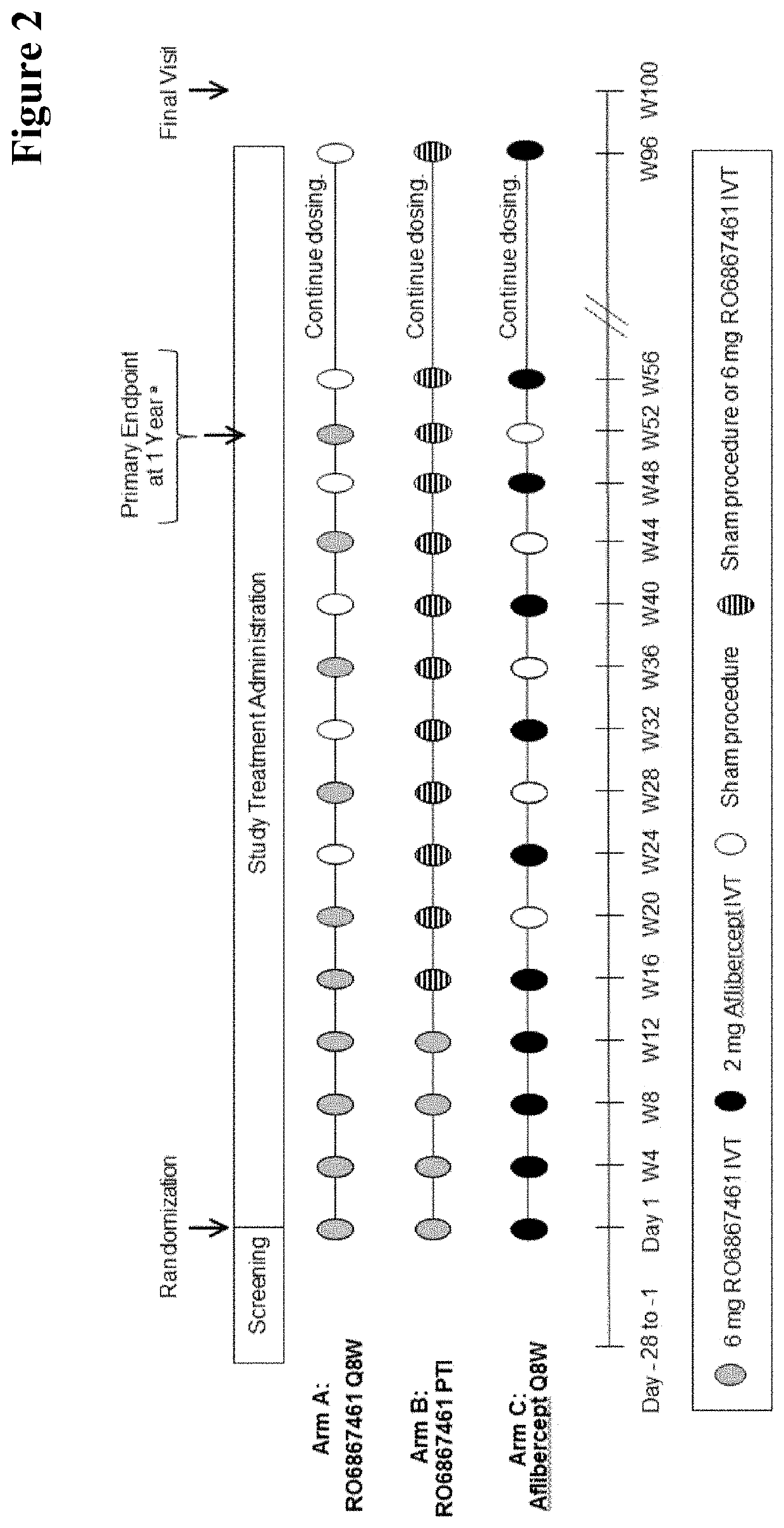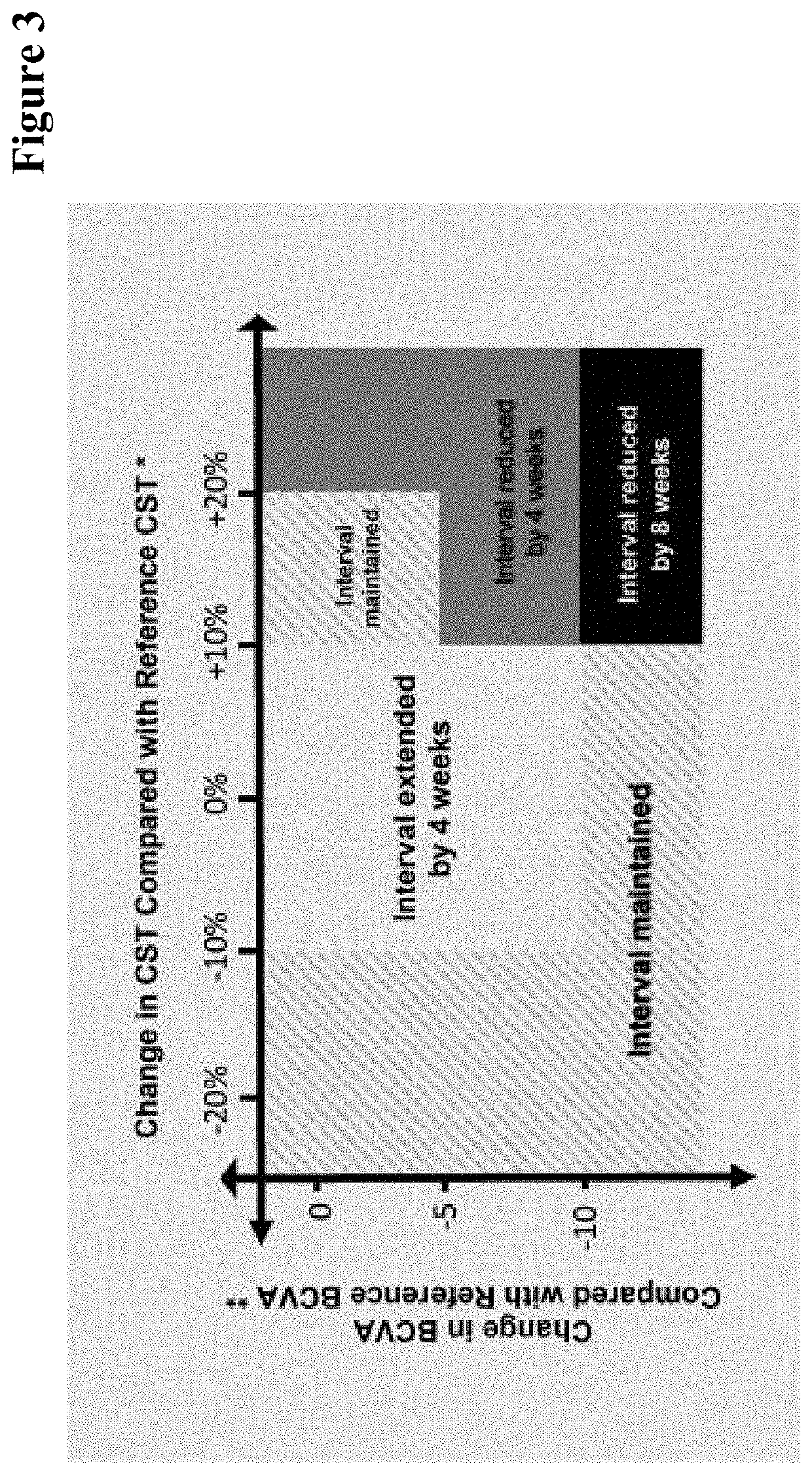Personalized treatment of ophthalmologic diseases
- Summary
- Abstract
- Description
- Claims
- Application Information
AI Technical Summary
Benefits of technology
Problems solved by technology
Method used
Image
Examples
example 1
[0657]Efficacy and Durability of Treatment of Patients Suffering from Neovascular Age-Related Macular Degeneration (nAMD) Using a Personalized Treatment Interval
[0658]In an earlier Phase II, 52-week study to investigate, inter alia, the efficacy of RO6867461 (faricimab) administered at 12- and 16-week intervals in treatment-naive patients with nAMD some potential of longer durability (potential longer time to retreatment) over all patients involved could be seen. Three arms were studied
[0659]Arm A (Q12W): 6 mg RO6867461 intravitreally (IVT) every 4 weeks up to Week 12 (4 injections), followed by 6 mg RO6867461 IVT every 12 weeks up to Week 48 (injections at Weeks 24, 36, and 48; 3 injections)
[0660]Arm B (Q16W): 6 mg RO6867461 IVT every 4 weeks up to Week 12 (4 injections), followed by 6 mg RO6867461 IVT every 16 weeks up to Week 48 (injections at Weeks 28 and 44; 2 injections)
[0661]Arm C (comparator arm): 0.5 mg ranibizumab IVT every 4 weeks for 48 weeks (13 injections) Only one eye...
example 2
[0724]Efficacy and Durability of Bispecific Anti-VEGF / ANG2 Treatment of Patients Suffering from Diabetic Macular Edema (DME) Using a Personalized Treatment Interval
[0725]In an earlier Phase II, 36-week study in patients with diabetic macular edema (DME) some potential of longer durability (potential longer time to retreatment) over all patients involved could be seen. The three study groups were treated as follows: Arm A: 0.3 mg ranibizumab intravitreal (IVT); Arm B: 1.5 mg RO6867461 (faricimab) IVT; Arm C: 6 mg RO6867461 (faricimab) IVT.
[0726]Results with respect to the potential longer time to retreatment for RO6867461 (faricimab, VA2) are shown in FIG. 6. FIG. 6 shows the time to retreatment in DME patients after dosing has discontinued (after 20 weeks or 6 monthly doses=Time post last intravitreal (IVT) administration) based on disease activity assessed by both: BCVA decreased by ≥5 letters and CST increased by ≥50 μm (=patients with an event). The bispecific anti-VEGF / ANG2 anti...
example 3
[0792]Efficacy and Durability of Bispecific Anti-VEGF / ANG2 Treatment of Patients Suffering from Macular Edema Secondary to Retinal Vein Occlusion (RVO) (Macular Edema Secondary to Central Retinal Vein Occlusion (CRVO), Secondary to Hemiretinal Vein Occlusion (HRVO) or Secondary to Branch Vein Occlusion(BRVO)) Using a Personalized Treatment Interval
[0793]Nonclinical studies have shown that Ang-2 and VEGF act in concert to regulate the vasculature and to increase retinal endothelial cell permeability in vitro. Simultaneous inhibition of Ang-2 and VEGF with the bispecific monoclonal antibody faricimab led to a greater reduction in the leakiness and severity of choroidal neovascularization (CNV) lesions in a laser-induced CNV model in non-human primates compared with the molar equivalent of anti-VEGF (ranibizumab) or anti-Ang-2 alone. Earlier experiments using a mouse model of spontaneous CNV showed that dual inhibition of Ang-2 and VEGF consistently outperformed monotherapeutic inhibit...
PUM
| Property | Measurement | Unit |
|---|---|---|
| Length | aaaaa | aaaaa |
| Length | aaaaa | aaaaa |
| Length | aaaaa | aaaaa |
Abstract
Description
Claims
Application Information
 Login to View More
Login to View More - R&D
- Intellectual Property
- Life Sciences
- Materials
- Tech Scout
- Unparalleled Data Quality
- Higher Quality Content
- 60% Fewer Hallucinations
Browse by: Latest US Patents, China's latest patents, Technical Efficacy Thesaurus, Application Domain, Technology Topic, Popular Technical Reports.
© 2025 PatSnap. All rights reserved.Legal|Privacy policy|Modern Slavery Act Transparency Statement|Sitemap|About US| Contact US: help@patsnap.com



